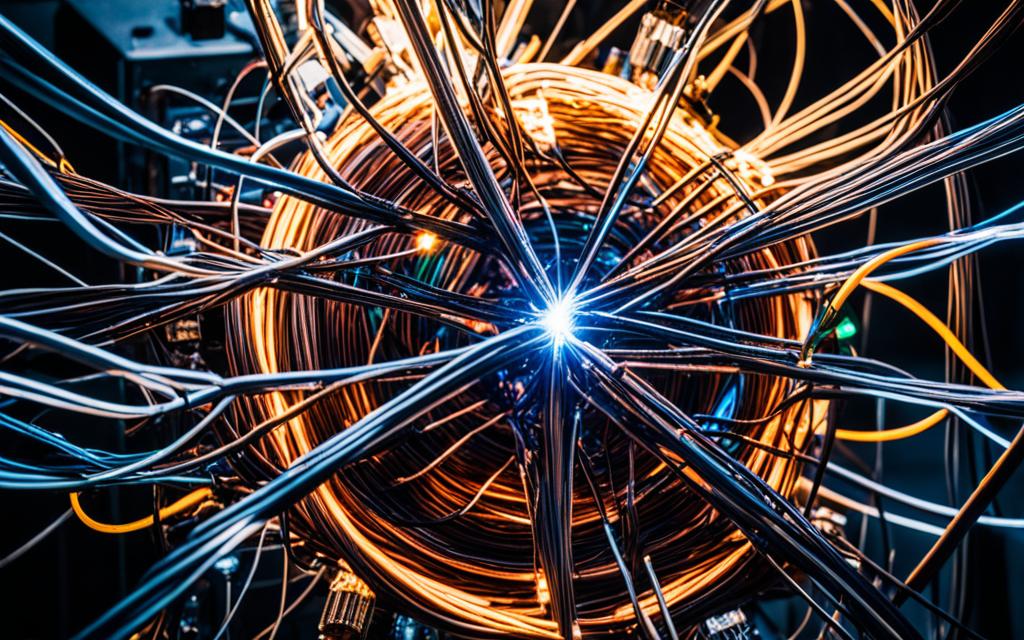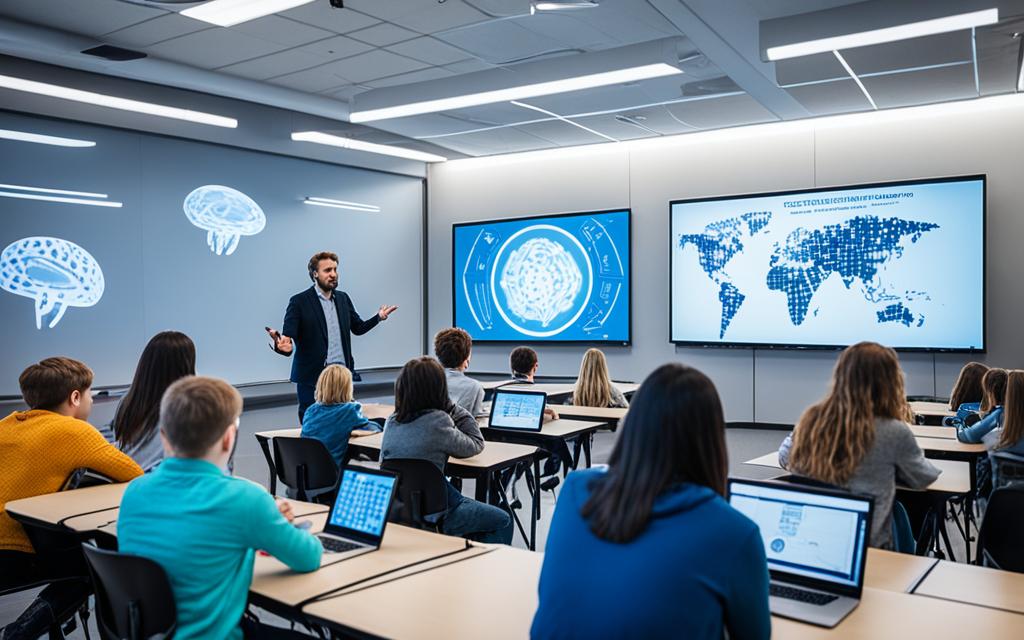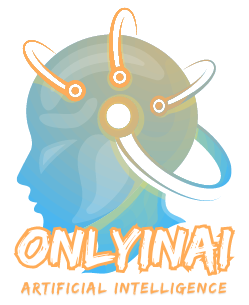Did you know AI systems can keep and spread biases, causing real discrimination? A study showed over 50% of AI in hiring made choices based on gender and race. As AI gets more into our lives, from social media to justice, we must see how it can unfairly affect some people.
This article will show you the top signs AI can be biased. We’ll help you spot and fix these biases. By focusing on fairness and ethics in AI, we can make sure it helps everyone equally.
Key Takeaways
- AI systems can keep and spread biases, causing real discrimination.
- Knowing how AI can discriminate is key as it becomes a bigger part of our lives.
- This article will give you a full guide on spotting the top signs of AI bias.
- It’s vital to focus on fairness, diversity, and ethics in AI making and using.
- Fixing AI bias and discrimination is crucial for making sure AI helps everyone the same.
What is AI Bias and How Does it Lead to Discrimination?
AI is now a big part of our lives, from our smartphones to online recommendations. But, these AI systems can be biased, leading to unfair outcomes. This bias affects certain communities more than others.
Explaining AI, Algorithms, and Machine Learning
Machine learning is key to modern AI. It trains software to recognize patterns and do tasks by learning from data. But, if the data is biased or lacks diversity, the AI can learn and keep those biases.
For instance, an AI meant to review job applications might favor certain groups if its training data only includes resumes from those groups. This is AI bias. It can lead to unfair hiring and more machine learning bias in many areas.
Knowing how AI works helps us see how biases can cause AI discrimination. We need to fix the biases in data and make AI more inclusive and ethical. This way, technology can help everyone, no matter their background or identity.
Have I Encountered AI Bias in My Daily Life?
AI is now a big part of our daily lives, and it’s likely you’ve seen AI bias without realizing it. From social media and online shopping to voice assistants and chatbots, these systems can show biases. These biases can lead to discrimination in ways we don’t expect.
Facial recognition software has had trouble with darker skin tones, causing wrong arrests. Voice assistants like Siri and Alexa don’t always work well with certain accents or dialects. With generative AI tools like ChatGPT becoming more common, the risk of bias in these systems is growing.
We see AI bias in everyday life, AI discrimination in technology, and algorithmic bias in social media a lot. It’s important to be aware of this and demand better from tech companies. Knowing about AI-powered assistants bias and generative AI bias helps us use technology more carefully. It also helps us push for more fair and ethical AI.
AI bias might not always be obvious, but being alert and spotting it can help us fix these problems. This way, we can work towards a digital world that’s fair, just, and includes everyone.
Who is Harmed Most by AI Bias?
AI bias has a big problem, mainly hurting marginalized communities. These include racial minorities, women, and people with disabilities. They face the worst effects when AI systems are biased.
The Impact of AI Bias in the Criminal Justice System
In the criminal justice system, AI bias is a big issue. Risk assessment algorithms often favor whites, leading to tougher sentences for Blacks. Facial recognition technology also makes mistakes more often with people of color, causing more racial profiling and wrong arrests.
AI bias also affects hiring, lending, and healthcare. It keeps repeating old inequalities and takes away chances from those who already have less. This shows how important it is to make AI fairer and more responsible.
| Marginalized Group | Examples of AI Bias Impact |
|---|---|
| Racial Minorities | Racial bias in recidivism risk assessment algorithms, inaccurate facial recognition technology leading to wrongful arrests |
| Women | Gender bias in hiring and lending decisions, underrepresentation in training data for AI systems |
| Individuals with Disabilities | Accessibility challenges in AI-powered technologies, lack of representation in training data |
AI bias hurts marginalized communities a lot. We need to fix this fast. By making AI fairer and more ethical, we can make sure technology helps everyone, no matter who they are.
The Challenges of Debiasing AI Systems

Mitigating AI bias and ensuring algorithmic fairness is hard. Efforts to “debias” machine learning models face big hurdles. The bias can be deep in the training data, algorithms, and how the system is made.
Some think making an algorithm “blind” to race or gender will fix bias. But, the system might still find other ways to use those attributes, causing more discrimination. Diversifying the training data helps, but it’s not enough. The data can still show the biases of society.
To truly make bias-aware AI, we need a full approach. This means focusing on inclusive design and development. It’s key to have diverse perspectives and involve many experts and stakeholders. Working together is the only way to effectively debias machine learning models and ensure fair data in AI.
| Key Challenges in Debiasing AI Systems | Potential Solutions |
|---|---|
| Bias in training data | Diversify data sources, actively seek out underrepresented perspectives |
| Bias in algorithms and model design | Involve interdisciplinary teams, prioritize inclusive development practices |
| Difficulty in identifying and measuring bias | Develop robust bias-detection frameworks, emphasize transparency and accountability |
Debiasing AI systems needs ongoing, team work. By tackling the complex issue of AI bias, we aim for more fair and equal machine learning models. These models should help everyone in society.
Top 10 Signs of discrimination in AI behavior
As AI becomes more common in our lives, it’s key to watch for signs of bias. AI bias can cause unfair treatment, which goes against the goal of making our lives better. Here are the top 10 signs that might show AI is biased or discriminatory.
- Disproportionate errors or inaccuracies affecting certain groups
- Biased recommendations or decisions that help or hurt specific groups
- Lack of diversity in the data used to train AI
- Not considering the unique experiences of different groups
- Keeping old biases and unfairness alive
- Different performance based on race, gender, age, or other groups
- Unpredictable or unclear decision-making
- AI’s inner workings not being clear
- No real human check or responsibility
- Not wanting outside checks for bias
Knowing these signs of AI bias and discrimination helps us fix these issues. This way, AI systems can treat everyone fairly and justly.
The Importance of Diversity and Ethical Considerations
Dealing with diversity in AI, bias, and discrimination needs a full plan. It must focus on making things more inclusive and ethical. Having diverse teams for AI design and use is key. Without enough diversity, AI might miss important things and keep old biases.
It’s vital to make inclusive AI design happen. This means getting people from different backgrounds involved. It helps spot and fix algorithmic biases that come from limited views. Also, making sure AI is made with ethical AI development in mind is crucial. This way, AI can be trusted and fair for everyone.
Promoting Inclusive AI Design and Development
Using bias-aware AI practices helps make AI teams more diverse and open. This means more different ideas and experiences are heard. It leads to better AI innovation and quality.
- Diversify the AI development team to include individuals from diverse backgrounds, including underrepresented groups.
- Involve a range of stakeholders, including those from marginalized communities, in the AI design and development process.
- Continuously evaluate AI systems for potential biases and implement strategies to mitigate them.
- Promote a culture of ethical AI development, where the potential societal impacts are carefully considered.
By doing these things, companies can work towards making ethical AI. This AI will be more open, trustworthy, and good for everyone.
Accountability and Transparency in AI Systems
Ensuring AI accountability and AI transparency is key to tackling bias and discrimination in AI. As AI plays a bigger role in making important decisions, it must be tested for bias and the results shared with the public.
Those creating and using AI systems need to take responsibility for any harm caused by bias. It’s also important for AI to be clear in how it works. This way, experts can check it and work on making explainable AI that explains its choices.
Using algorithmic auditing and bias testing for AI builds trust in these technologies. It lets people and groups hold the companies behind them to account. By focusing on transparency and accountability, we can make sure AI doesn’t unfairly discriminate against anyone.
- Ensure AI systems are subject to rigorous bias testing and algorithmic auditing
- Developers and organizations must be held accountable for biased outcomes
- Promote transparent and explainable AI models to enable independent scrutiny
- Prioritize transparency and accountability to build trust in AI systems
Working on AI accountability and AI transparency helps us use these powerful tools to better lives, not worsen discrimination. It’s a vital step towards making sure AI’s benefits reach everyone fairly.
The Role of Education and Awareness

Dealing with AI bias and discrimination needs a big push to educate the public and raise awareness. By adding AI ethics and how these technologies affect society to school programs, we can train a new group of tech experts and citizens. They will know how to spot and fix biases.
Also, fostering AI literacy and giving easy-to-understand resources helps people understand AI better. This lets people check the AI tools they use every day. With more knowledge, we can make sure AI is fair and trustworthy for everyone.
- Integrate AI ethics and societal impact into school programs
- Promote AI literacy with easy resources and public classes
- Help people question AI tools they use daily
- Train a new group of tech experts and citizens to spot and fix AI bias
- Make AI developers and deployers more accountable
By doing these things, we can raise awareness about AI discrimination and teach AI ethics. This helps build a more equitable and trustworthy artificial intelligence world for all.
Conclusion
As we move forward with artificial intelligence, tackling bias and discrimination is crucial. The signs of AI bias, like unfair errors and keeping old inequalities, show us the big task ahead.
To make AI work for everyone, we must focus on addressing AI bias, mitigating AI discrimination, and promoting fair and ethical AI development. We need a plan that values diversity, inclusion, and ethics in AI.
By making AI systems accountable and transparent, and teaching people about AI literacy, we can aim for a fairer AI future. As we explore new tech, let’s always remember the human side. This ensures the future of AI development helps everyone.


